Chapter 3.3: The Limit of a Function
Learning Objectives
- Using correct notation, describe the limit of a function.
- Use a table of values to estimate the limit of a function or to identify when the limit does not exist.
- Use a graph to estimate the limit of a function or to identify when the limit does not exist.
- Define one-sided limits and provide examples.
- Explain the relationship between one-sided and two-sided limits.
- Using correct notation, describe an infinite limit.
- Define a vertical asymptote.
The concept of a limit or limiting process, essential to the understanding of calculus, has been around for thousands of years. In fact, early mathematicians used a limiting process to obtain better and better approximations of areas of circles. Yet, the formal definition of a limit—as we know and understand it today—did not appear until the late 19th century. We therefore begin our quest to understand limits, as our mathematical ancestors did, by using an intuitive approach. At the end of this chapter, armed with a conceptual understanding of limits, we examine the formal definition of a limit.
We begin our exploration of limits by taking a look at the graphs of the functions
which are shown in (Figure). In particular, let’s focus our attention on the behavior of each graph at and around ![]() .
.
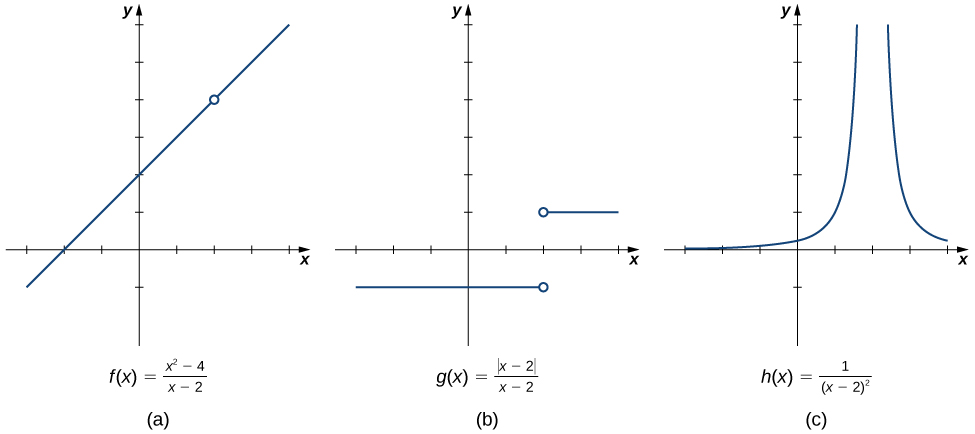
Each of the three functions is undefined at ![]() , but if we make this statement and no other, we give a very incomplete picture of how each function behaves in the vicinity of
, but if we make this statement and no other, we give a very incomplete picture of how each function behaves in the vicinity of ![]() . To express the behavior of each graph in the vicinity of 2 more completely, we need to introduce the concept of a limit.
. To express the behavior of each graph in the vicinity of 2 more completely, we need to introduce the concept of a limit.
Intuitive Definition of a Limit
Let’s first take a closer look at how the function ![]() behaves around
behaves around ![]() in (Figure). As the values of
in (Figure). As the values of ![]() approach 2 from either side of 2, the values of
approach 2 from either side of 2, the values of ![]() approach 4. Mathematically, we say that the limit of
approach 4. Mathematically, we say that the limit of ![]() as
as ![]() approaches 2 is 4. Symbolically, we express this limit as
approaches 2 is 4. Symbolically, we express this limit as
From this very brief informal look at one limit, let’s start to develop an intuitive definition of the limit. We can think of the limit of a function at a number ![]() as being the one real number
as being the one real number ![]() that the functional values approach as the
that the functional values approach as the ![]() -values approach
-values approach ![]() , provided such a real number
, provided such a real number ![]() exists. Stated more carefully, we have the following definition:
exists. Stated more carefully, we have the following definition:
Definition
Let ![]() be a function defined at all values in an open interval containing
be a function defined at all values in an open interval containing ![]() , with the possible exception of
, with the possible exception of ![]() itself, and let
itself, and let ![]() be a real number. If all values of the function
be a real number. If all values of the function ![]() approach the real number
approach the real number ![]() as the values of
as the values of ![]() approach the number
approach the number ![]() , then we say that the limit of
, then we say that the limit of ![]() as
as ![]() approaches
approaches ![]() is
is ![]() . (More succinct, as
. (More succinct, as ![]() gets closer to
gets closer to ![]() ,
, ![]() gets closer and stays close to
gets closer and stays close to ![]() .) Symbolically, we express this idea as
.) Symbolically, we express this idea as
We can estimate limits by constructing tables of functional values and by looking at their graphs. This process is described in the following Problem-Solving Strategy.
Problem-Solving Strategy: Evaluating a Limit Using a Table of Functional Values
- To evaluate
 , we begin by completing a table of functional values. We should choose two sets of
, we begin by completing a table of functional values. We should choose two sets of  -values—one set of values approaching
-values—one set of values approaching  and less than
and less than  , and another set of values approaching
, and another set of values approaching  and greater than
and greater than  . (Figure) demonstrates what your tables might look like.
. (Figure) demonstrates what your tables might look like.
Table of Functional Values for 




















Use additional values as necessary. Use additional values as necessary. - Next, let’s look at the values in each of the
 columns and determine whether the values seem to be approaching a single value as we move down each column. In our columns, we look at the sequence
columns and determine whether the values seem to be approaching a single value as we move down each column. In our columns, we look at the sequence  and so on, and
and so on, and  and so on. (Note: Although we have chosen the
and so on. (Note: Although we have chosen the  -values
-values  , and so forth, and these values will probably work nearly every time, on very rare occasions we may need to modify our choices.)
, and so forth, and these values will probably work nearly every time, on very rare occasions we may need to modify our choices.) - If both columns approach a common
 -value
-value  , we state
, we state  . We can use the following strategy to confirm the result obtained from the table or as an alternative method for estimating a limit.
. We can use the following strategy to confirm the result obtained from the table or as an alternative method for estimating a limit. - Using a graphing calculator or computer software that allows us graph functions, we can plot the function
 , making sure the functional values of
, making sure the functional values of  for
for  -values near
-values near  are in our window. We can use the trace feature to move along the graph of the function and watch the
are in our window. We can use the trace feature to move along the graph of the function and watch the  -value readout as the
-value readout as the  -values approach
-values approach  . If the
. If the  -values approach
-values approach  as our
as our  -values approach
-values approach  from both directions, then
from both directions, then  . We may need to zoom in on our graph and repeat this process several times.
. We may need to zoom in on our graph and repeat this process several times.
We apply this Problem-Solving Strategy to compute a limit in (Figure).
Evaluating a Limit Using a Table of Functional Values 1
Evaluate ![]() using a table of functional values.
using a table of functional values.
Solution
We have calculated the values of ![]() for the values of
for the values of ![]() listed in (Figure).
listed in (Figure).
| |
|
|
|
|
|---|---|---|---|---|
| −0.1 | 0.998334166468 | 0.1 | 0.998334166468 | |
| −0.01 | 0.999983333417 | 0.01 | 0.999983333417 | |
| −0.001 | 0.999999833333 | 0.001 | 0.999999833333 | |
| −0.0001 | 0.999999998333 | 0.0001 | 0.999999998333 |
Note: The values in this table were obtained using a calculator and using all the places given in the calculator output.
As we read down each ![]() column, we see that the values in each column appear to be approaching one. Thus, it is fairly reasonable to conclude that
column, we see that the values in each column appear to be approaching one. Thus, it is fairly reasonable to conclude that ![]() . A calculator-or computer-generated graph of
. A calculator-or computer-generated graph of ![]() would be similar to that shown in (Figure), and it confirms our estimate.
would be similar to that shown in (Figure), and it confirms our estimate.
![A graph of f(x) = sin(x)/x over the interval [-6, 6]. The curving function has a y intercept at x=0 and x intercepts at y=pi and y=-pi.](https://s3-us-west-2.amazonaws.com/courses-images/wp-content/uploads/sites/2332/2018/01/11202852/CNX_Calc_Figure_02_02_003.jpg)
 confirms the estimate from the table.
confirms the estimate from the table.Evaluating a Limit Using a Table of Functional Values 2
Evaluate ![]() using a table of functional values.
using a table of functional values.
Solution
As before, we use a table—in this case, (Figure)—to list the values of the function for the given values of ![]() .
.
| |
|
|
|
|
|---|---|---|---|---|
| 3.9 | 0.251582341869 | 4.1 | 0.248456731317 | |
| 3.99 | 0.25015644562 | 4.01 | 0.24984394501 | |
| 3.999 | 0.250015627 | 4.001 | 0.249984377 | |
| 3.9999 | 0.250001563 | 4.0001 | 0.249998438 | |
| 3.99999 | 0.25000016 | 4.00001 | 0.24999984 |
After inspecting this table, we see that the functional values less than 4 appear to be decreasing toward 0.25 whereas the functional values greater than 4 appear to be increasing toward 0.25. We conclude that ![]() . We confirm this estimate using the graph of
. We confirm this estimate using the graph of ![]() shown in (Figure).
shown in (Figure).
![A graph of the function f(x) = (sqrt(x) – 2 ) / (x-4) over the interval [0,8]. There is an open circle on the function at x=4. The function curves asymptotically towards the x axis and y axis in quadrant one.](https://s3-us-west-2.amazonaws.com/courses-images/wp-content/uploads/sites/2332/2018/01/11202855/CNX_Calc_Figure_02_02_004.jpg)
 confirms the estimate from the table.
confirms the estimate from the table.Estimate ![]() using a table of functional values. Use a graph to confirm your estimate.
using a table of functional values. Use a graph to confirm your estimate.
Solution
![]()
At this point, we see from (Figure) and (Figure) that it may be just as easy, if not easier, to estimate a limit of a function by inspecting its graph as it is to estimate the limit by using a table of functional values. In (Figure), we evaluate a limit exclusively by looking at a graph rather than by using a table of functional values.
Evaluating a Limit Using a Graph
For ![]() shown in (Figure), evaluate
shown in (Figure), evaluate ![]() .
.

 includes one value not on a smooth curve.
includes one value not on a smooth curve.Solution
Despite the fact that ![]() , as the
, as the ![]() -values approach −1 from either side, the
-values approach −1 from either side, the ![]() values approach 3. Therefore,
values approach 3. Therefore, ![]() . Note that we can determine this limit without even knowing the algebraic expression of the function.
. Note that we can determine this limit without even knowing the algebraic expression of the function.
Based on (Figure), we make the following observation: It is possible for the limit of a function to exist at a point, and for the function to be defined at this point, but the limit of the function and the value of the function at the point may be different.
Use the graph of ![]() in (Figure) to evaluate
in (Figure) to evaluate ![]() , if possible.
, if possible.
![A graph of the function h(x), which is a parabola graphed over [-2.5, 5]. There is an open circle where the vertex should be at the point (2,-1).](https://s3-us-west-2.amazonaws.com/courses-images/wp-content/uploads/sites/2332/2018/01/11202902/CNX_Calc_Figure_02_02_007.jpg)
 consists of a smooth graph with a single removed point at
consists of a smooth graph with a single removed point at  .
.Solution
![]() .
.
Hint
What ![]() -value does the function approach as the
-value does the function approach as the ![]() -values approach 2?
-values approach 2?
Looking at a table of functional values or looking at the graph of a function provides us with useful insight into the value of the limit of a function at a given point. However, these techniques rely too much on guesswork. We eventually need to develop alternative methods of evaluating limits. These new methods are more algebraic in nature and we explore them in the next section; however, at this point we introduce two special limits that are foundational to the techniques to come.
Two Important Limits
Let ![]() be a real number and
be a real number and ![]() be a constant.
be a constant.
We can make the following observations about these two limits.
- For the first limit, observe that as
 approaches
approaches  , so does
, so does  , because
, because  . Consequently,
. Consequently,  .
. - For the second limit, consider (Figure).
| |
|
|
|
|
|---|---|---|---|---|
| |
|
|
|
|
| |
|
|
|
|
| |
|
|
|
|
| |
|
|
|
Observe that for all values of ![]() (regardless of whether they are approaching
(regardless of whether they are approaching ![]() ), the values
), the values ![]() remain constant at
remain constant at ![]() . We have no choice but to conclude
. We have no choice but to conclude ![]() .
.
The Existence of a Limit
As we consider the limit in the next example, keep in mind that for the limit of a function to exist at a point, the functional values must approach a single real-number value at that point. If the functional values do not approach a single value, then the limit does not exist.
Evaluating a Limit That Fails to Exist
Evaluate ![]() using a table of values.
using a table of values.
Solution
(Figure) lists values for the function ![]() for the given values of
for the given values of ![]() .
.
| |
|
|
|
|
|---|---|---|---|---|
| −0.1 | 0.544021110889 | 0.1 | −0.544021110889 | |
| −0.01 | 0.50636564111 | 0.01 | −0.50636564111 | |
| −0.001 | −0.8268795405312 | 0.001 | 0.826879540532 | |
| −0.0001 | 0.305614388888 | 0.0001 | −0.305614388888 | |
| −0.00001 | −0.035748797987 | 0.00001 | 0.035748797987 | |
| −0.000001 | 0.349993504187 | 0.000001 | −0.349993504187 |
After examining the table of functional values, we can see that the ![]() -values do not seem to approach any one single value. It appears the limit does not exist. Before drawing this conclusion, let’s take a more systematic approach. Take the following sequence of
-values do not seem to approach any one single value. It appears the limit does not exist. Before drawing this conclusion, let’s take a more systematic approach. Take the following sequence of ![]() -values approaching 0:
-values approaching 0:
The corresponding ![]() -values are
-values are
At this point we can indeed conclude that ![]() does not exist. (Mathematicians frequently abbreviate “does not exist” as DNE. Thus, we would write
does not exist. (Mathematicians frequently abbreviate “does not exist” as DNE. Thus, we would write ![]() DNE.) The graph of
DNE.) The graph of ![]() is shown in (Figure) and it gives a clearer picture of the behavior of
is shown in (Figure) and it gives a clearer picture of the behavior of ![]() as
as ![]() approaches 0. You can see that
approaches 0. You can see that ![]() oscillates ever more wildly between −1 and 1 as
oscillates ever more wildly between −1 and 1 as ![]() approaches 0.
approaches 0.
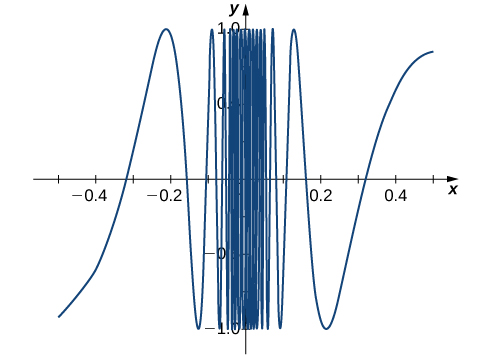
 oscillates rapidly between −1 and 1 as x approaches 0.
oscillates rapidly between −1 and 1 as x approaches 0.Use a table of functional values to evaluate ![]() , if possible.
, if possible.
Solution
![]() does not exist.
does not exist.
Hint
Use ![]() -values 1.9, 1.99, 1.999, 1.9999, 1.9999 and 2.1, 2.01, 2.001, 2.0001, 2.00001 in your table.
-values 1.9, 1.99, 1.999, 1.9999, 1.9999 and 2.1, 2.01, 2.001, 2.0001, 2.00001 in your table.
One-Sided Limits
Sometimes indicating that the limit of a function fails to exist at a point does not provide us with enough information about the behavior of the function at that particular point. To see this, we now revisit the function ![]() introduced at the beginning of the section (see (Figure)(b)). As we pick values of
introduced at the beginning of the section (see (Figure)(b)). As we pick values of ![]() close to 2,
close to 2, ![]() does not approach a single value, so the limit as
does not approach a single value, so the limit as ![]() approaches 2 does not exist—that is,
approaches 2 does not exist—that is, ![]() DNE. However, this statement alone does not give us a complete picture of the behavior of the function around the
DNE. However, this statement alone does not give us a complete picture of the behavior of the function around the ![]() -value 2. To provide a more accurate description, we introduce the idea of a one-sided limit. For all values to the left of 2 (or the negative side of 2),
-value 2. To provide a more accurate description, we introduce the idea of a one-sided limit. For all values to the left of 2 (or the negative side of 2), ![]() . Thus, as
. Thus, as ![]() approaches 2 from the left,
approaches 2 from the left, ![]() approaches −1. Mathematically, we say that the limit as
approaches −1. Mathematically, we say that the limit as ![]() approaches 2 from the left is −1. Symbolically, we express this idea as
approaches 2 from the left is −1. Symbolically, we express this idea as
Similarly, as ![]() approaches 2 from the right (or from the positive side),
approaches 2 from the right (or from the positive side), ![]() approaches 1. Symbolically, we express this idea as
approaches 1. Symbolically, we express this idea as
We can now present an informal definition of one-sided limits.
Definition
We define two types of one-sided limits.
Limit from the left: Let ![]() be a function defined at all values in an open interval of the form z, and let
be a function defined at all values in an open interval of the form z, and let ![]() be a real number. If the values of the function
be a real number. If the values of the function ![]() approach the real number
approach the real number ![]() as the values of
as the values of ![]() (where
(where ![]() ) approach the number
) approach the number ![]() , then we say that
, then we say that ![]() is the limit of
is the limit of ![]() as
as ![]() approaches a from the left. Symbolically, we express this idea as
approaches a from the left. Symbolically, we express this idea as
Limit from the right: Let ![]() be a function defined at all values in an open interval of the form
be a function defined at all values in an open interval of the form ![]() , and let
, and let ![]() be a real number. If the values of the function
be a real number. If the values of the function ![]() approach the real number
approach the real number ![]() as the values of
as the values of ![]() (where
(where ![]() ) approach the number
) approach the number ![]() , then we say that
, then we say that ![]() is the limit of
is the limit of ![]() as
as ![]() approaches
approaches ![]() from the right. Symbolically, we express this idea as
from the right. Symbolically, we express this idea as
Evaluating One-Sided Limits
For the function  , evaluate each of the following limits.
, evaluate each of the following limits.
Solution
We can use tables of functional values again (Figure). Observe that for values of ![]() less than 2, we use
less than 2, we use ![]() and for values of
and for values of ![]() greater than 2, we use
greater than 2, we use ![]() .
.
| |
|
|
|
|
|---|---|---|---|---|
| 1.9 | 2.9 | 2.1 | 0.41 | |
| 1.99 | 2.99 | 2.01 | 0.0401 | |
| 1.999 | 2.999 | 2.001 | 0.004001 | |
| 1.9999 | 2.9999 | 2.0001 | 0.00040001 | |
| 1.99999 | 2.99999 | 2.00001 | 0.0000400001 |
Based on this table, we can conclude that a. ![]() and b.
and b. ![]() . Therefore, the (two-sided) limit of
. Therefore, the (two-sided) limit of ![]() does not exist at
does not exist at ![]() . (Figure) shows a graph of
. (Figure) shows a graph of ![]() and reinforces our conclusion about these limits.
and reinforces our conclusion about these limits.
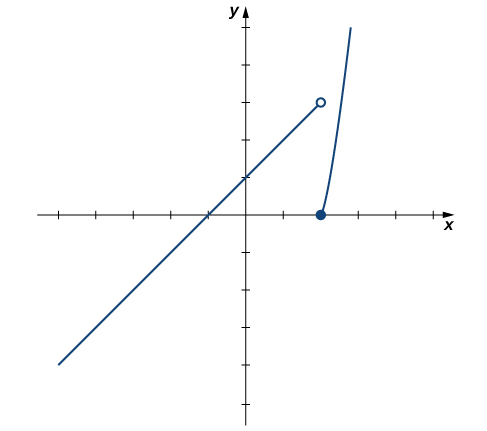
 has a break at
has a break at Use a table of functional values to estimate the following limits, if possible.
Solution
a. ![]() ; b.
; b. ![]()
Hint
- Use
 -values 1.9, 1.99, 1.999, 1.9999, 1.9999 to estimate
-values 1.9, 1.99, 1.999, 1.9999, 1.9999 to estimate  .
. - Use
 -values 2.1, 2.01, 2.001, 2.0001, 2.00001 to estimate
-values 2.1, 2.01, 2.001, 2.0001, 2.00001 to estimate  .
.
(These tables are available from a previous Checkpoint problem.)
Let us now consider the relationship between the limit of a function at a point and the limits from the right and left at that point. It seems clear that if the limit from the right and the limit from the left have a common value, then that common value is the limit of the function at that point. Similarly, if the limit from the left and the limit from the right take on different values, the limit of the function does not exist. These conclusions are summarized in (Figure).
Relating One-Sided and Two-Sided Limits
Let ![]() be a function defined at all values in an open interval containing
be a function defined at all values in an open interval containing ![]() , with the possible exception of
, with the possible exception of ![]() itself, and let
itself, and let ![]() be a real number. Then,
be a real number. Then,
Infinite Limits
Evaluating the limit of a function at a point or evaluating the limit of a function from the right and left at a point helps us to characterize the behavior of a function around a given value. As we shall see, we can also describe the behavior of functions that do not have finite limits.
We now turn our attention to ![]() , the third and final function introduced at the beginning of this section (see (Figure)(c)). From its graph we see that as the values of
, the third and final function introduced at the beginning of this section (see (Figure)(c)). From its graph we see that as the values of ![]() approach 2, the values of
approach 2, the values of ![]() become larger and larger and, in fact, become infinite. Mathematically, we say that the limit of
become larger and larger and, in fact, become infinite. Mathematically, we say that the limit of ![]() as
as ![]() approaches 2 is positive infinity. Symbolically, we express this idea as
approaches 2 is positive infinity. Symbolically, we express this idea as
More generally, we define infinite limits as follows:
Definition
We define three types of infinite limits.
Infinite limits from the left: Let ![]() be a function defined at all values in an open interval of the form
be a function defined at all values in an open interval of the form ![]() .
.
- If the values of
 increase without bound as the values of
increase without bound as the values of  (where
(where  ) approach the number
) approach the number  , then we say that the limit as
, then we say that the limit as  approaches
approaches  from the left is positive infinity and we write
from the left is positive infinity and we write
 .
. - If the values of
 decrease without bound as the values of
decrease without bound as the values of  (where
(where  ) approach the number
) approach the number  , then we say that the limit as
, then we say that the limit as  approaches
approaches  from the left is negative infinity and we write
from the left is negative infinity and we write
 .
.
Infinite limits from the right: Let ![]() be a function defined at all values in an open interval of the form
be a function defined at all values in an open interval of the form ![]() .
.
- If the values of
 increase without bound as the values of
increase without bound as the values of  (where
(where  ) approach the number
) approach the number  , then we say that the limit as
, then we say that the limit as  approaches
approaches  from the left is positive infinity and we write
from the left is positive infinity and we write
 .
. - If the values of
 decrease without bound as the values of
decrease without bound as the values of  (where
(where  ) approach the number
) approach the number  , then we say that the limit as
, then we say that the limit as  approaches
approaches  from the left is negative infinity and we write
from the left is negative infinity and we write
 .
.
Two-sided infinite limit: Let ![]() be defined for all
be defined for all ![]() in an open interval containing
in an open interval containing ![]() .
.
- If the values of
 increase without bound as the values of
increase without bound as the values of  (where
(where  ) approach the number
) approach the number  , then we say that the limit as
, then we say that the limit as  approaches
approaches  is positive infinity and we write
is positive infinity and we write
 .
. - If the values of
 decrease without bound as the values of
decrease without bound as the values of  (where
(where  ) approach the number
) approach the number  , then we say that the limit as
, then we say that the limit as  approaches
approaches  is negative infinity and we write
is negative infinity and we write
 .
.
It is important to understand that when we write statements such as ![]() or
or ![]() we are describing the behavior of the function, as we have just defined it. We are not asserting that a limit exists. For the limit of a function
we are describing the behavior of the function, as we have just defined it. We are not asserting that a limit exists. For the limit of a function ![]() to exist at
to exist at ![]() , it must approach a real number
, it must approach a real number ![]() as
as ![]() approaches
approaches ![]() . That said, if, for example,
. That said, if, for example, ![]() , we always write
, we always write ![]() rather than
rather than ![]() DNE.
DNE.
Recognizing an Infinite Limit
Evaluate each of the following limits, if possible. Use a table of functional values and graph ![]() to confirm your conclusion.
to confirm your conclusion.
Solution
Begin by constructing a table of functional values.
| |
|
|
|
|
|---|---|---|---|---|
| −0.1 | −10 | 0.1 | 10 | |
| −0.01 | −100 | 0.01 | 100 | |
| −0.001 | −1000 | 0.001 | 1000 | |
| −0.0001 | −10,000 | 0.0001 | 10,000 | |
| −0.00001 | −100,000 | 0.00001 | 100,000 | |
| −0.000001 | −1,000,000 | 0.000001 | 1,000,000 |
- The values of
 decrease without bound as
decrease without bound as  approaches 0 from the left. We conclude that
approaches 0 from the left. We conclude that
 .
. - The values of
 increase without bound as
increase without bound as  approaches 0 from the right. We conclude that
approaches 0 from the right. We conclude that
 .
. - Since
 and
and  have different values, we conclude that
have different values, we conclude that
 DNE.
DNE.
The graph of ![]() in (Figure) confirms these conclusions.
in (Figure) confirms these conclusions.
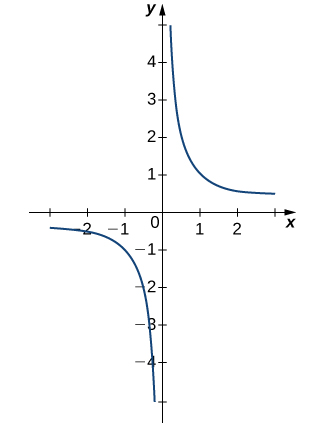
 confirms that the limit as
confirms that the limit as  approaches 0 does not exist.
approaches 0 does not exist.Evaluate each of the following limits, if possible. Use a table of functional values and graph ![]() to confirm your conclusion.
to confirm your conclusion.
Solution
a. ![]() ;
;
b. ![]() ;
;
c. ![]()
Hint
Follow the procedures from (Figure).
It is useful to point out that functions of the form ![]() , where
, where ![]() is a positive integer, have infinite limits as
is a positive integer, have infinite limits as ![]() approaches
approaches ![]() from either the left or right ((Figure)). These limits are summarized in (Figure).
from either the left or right ((Figure)). These limits are summarized in (Figure).
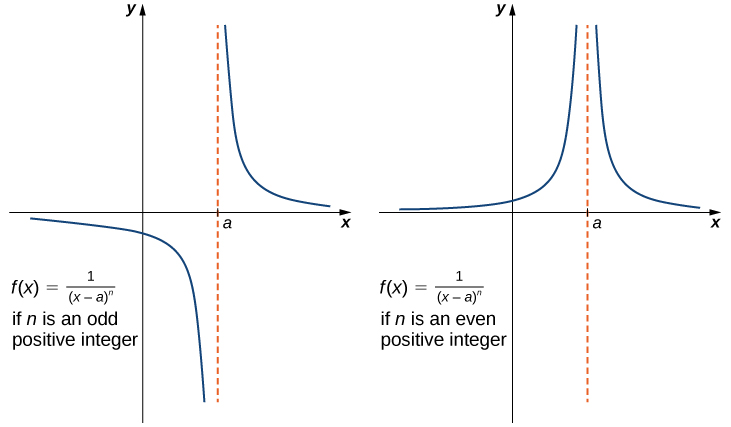
 has infinite limits at
has infinite limits at  .
.Infinite Limits from Positive Integers
If ![]() is a positive even integer, then
is a positive even integer, then
If ![]() is a positive odd integer, then
is a positive odd integer, then
and
We should also point out that in the graphs of ![]() , points on the graph having
, points on the graph having ![]() -coordinates very near to
-coordinates very near to ![]() are very close to the vertical line
are very close to the vertical line ![]() . That is, as
. That is, as ![]() approaches
approaches ![]() , the points on the graph of
, the points on the graph of ![]() are closer to the line
are closer to the line ![]() . The line
. The line ![]() is called a vertical asymptote of the graph. We formally define a vertical asymptote as follows:
is called a vertical asymptote of the graph. We formally define a vertical asymptote as follows:
Definition
Let ![]() be a function. If any of the following conditions hold, then the line
be a function. If any of the following conditions hold, then the line ![]() is a vertical asymptote of
is a vertical asymptote of ![]() :
:
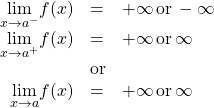
Finding a Vertical Asymptote
Evaluate each of the following limits. Identify any vertical asymptotes of the function ![]() .
.
Solution
a. ![]() ;
;
b. ![]() ;
;
c. ![]() DNE. The line
DNE. The line ![]() is the vertical asymptote of
is the vertical asymptote of ![]() .
.
Hint
Use (Figure).
In the next example we put our knowledge of various types of limits to use to analyze the behavior of a function at several different points.
Behavior of a Function at Different Points
Evaluate ![]() for
for ![]() shown here:
shown here:
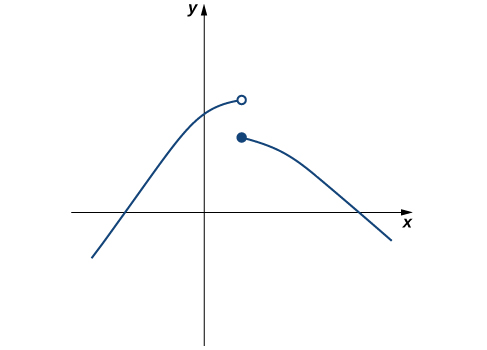
Solution
Does not exist.
Hint
Compare the limit from the right with the limit from the left.
Chapter Opener: Einstein’s Equation
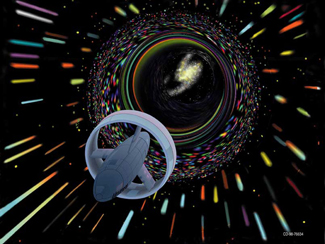
In the chapter opener we mentioned briefly how Albert Einstein showed that a limit exists to how fast any object can travel. Given Einstein’s equation for the mass of a moving object, what is the value of this bound?
Solution
Our starting point is Einstein’s equation for the mass of a moving object,
where ![]() is the object’s mass at rest,
is the object’s mass at rest, ![]() is its speed, and
is its speed, and ![]() is the speed of light. To see how the mass changes at high speeds, we can graph the ratio of masses
is the speed of light. To see how the mass changes at high speeds, we can graph the ratio of masses ![]() as a function of the ratio of speeds,
as a function of the ratio of speeds, ![]() ((Figure)).
((Figure)).
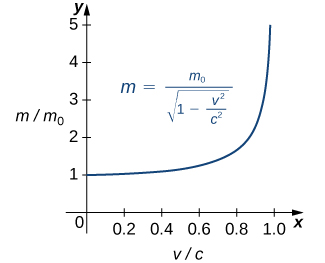
We can see that as the ratio of speeds approaches 1—that is, as the speed of the object approaches the speed of light—the ratio of masses increases without bound. In other words, the function has a vertical asymptote at ![]() . We can try a few values of this ratio to test this idea.
. We can try a few values of this ratio to test this idea.
| |
|
|
|---|---|---|
| 0.99 | 0.1411 | 7.089 |
| 0.999 | 0.0447 | 22.37 |
| 0.9999 | 0.0141 | 70.71 |
Thus, according to (Figure), if an object with mass 100 kg is traveling at 0.9999 ![]() , its mass becomes 7071 kg. Since no object can have an infinite mass, we conclude that no object can travel at or more than the speed of light.
, its mass becomes 7071 kg. Since no object can have an infinite mass, we conclude that no object can travel at or more than the speed of light.
Key Concepts
- A table of values or graph may be used to estimate a limit.
- If the limit of a function at a point does not exist, it is still possible that the limits from the left and right at that point may exist.
- If the limits of a function from the left and right exist and are equal, then the limit of the function is that common value.
- We may use limits to describe infinite behavior of a function at a point.
Key Equations
- Intuitive Definition of the Limit

- Two Important Limits


- One-Sided Limits


- Infinite Limits from the Left


- Infinite Limits from the Right


- Two-Sided Infinite Limits
 and
and 
 and
and 
For the following exercises, consider the function ![]() .
.
1. [T] Complete the following table for the function. Round your solutions to four decimal places.
| |
|
|
|
|---|---|---|---|
| 0.9 | a. | 1.1 | e. |
| 0.99 | b. | 1.01 | f. |
| 0.999 | c. | 1.001 | g. |
| 0.9999 | d. | 1.0001 | h. |
2. What do your results in the preceding exercise indicate about the two-sided limit ![]() ? Explain your response.
? Explain your response.
Solution
![]() does not exist because
does not exist because ![]() .
.
For the following exercises, consider the function ![]() .
.
3. [T] Make a table showing the values of ![]() for
for ![]() and for
and for ![]() . Round your solutions to five decimal places.
. Round your solutions to five decimal places.
| |
|
|
|
|---|---|---|---|
| −0.01 | a. | 0.01 | e. |
| −0.001 | b. | 0.001 | f. |
| −0.0001 | c. | 0.0001 | g. |
| −0.00001 | d. | 0.00001 | h. |
4. What does the table of values in the preceding exercise indicate about the function ![]() ?
?
Solution
![]()
5. To which mathematical constant does the limit in the preceding exercise appear to be getting closer?
In the following exercises, use the given values of ![]() to set up a table to evaluate the limits. Round your solutions to eight decimal places.
to set up a table to evaluate the limits. Round your solutions to eight decimal places.
6. [T] ![]()
| |
|
|
|
|---|---|---|---|
| −0.1 | a. | 0.1 | e. |
| −0.01 | b. | 0.01 | f. |
| −0.001 | c. | 0.001 | g. |
| −0.0001 | d. | 0.0001 | h. |
Solution
a. 1.98669331; b. 1.99986667; c. 1.99999867; d. 1.99999999; e. 1.98669331; f. 1.99986667; g. 1.99999867; h. 1.99999999; ![]()
7. [T] ![]()
| X | |
|
|
|---|---|---|---|
| −0.1 | a. | 0.1 | e. |
| −0.01 | b. | 0.01 | f. |
| −0.001 | c. | 0.001 | g. |
| −0.0001 | d. | 0.0001 | h. |
8. Use the preceding two exercises to conjecture (guess) the value of the following limit: ![]() for
for ![]() , a positive real value.
, a positive real value.
Solution
![]()
In the following exercises, set up a table of values to find the indicated limit. Round to eight digits.
9. [T] ![]()
| |
|
|
|
|---|---|---|---|
| 1.9 | a. | 2.1 | e. |
| 1.99 | b. | 2.01 | f. |
| 1.999 | c. | 2.001 | g. |
| 1.9999 | d. | 2.0001 | h. |
10. [T] ![]()
| |
|
|
|
|---|---|---|---|
| 0.9 | a. | 1.1 | e. |
| 0.99 | b. | 1.01 | f. |
| 0.999 | c. | 1.001 | g. |
| 0.9999 | d. | 1.0001 | h. |
Solution
a. −0.80000000; b. −0.98000000; c. −0.99800000; d. −0.99980000; e. −1.2000000; f. −1.0200000; g. −1.0020000; h. −1.0002000;
![]()
11. [T] ![]()
| |
|
|
|
|---|---|---|---|
| −0.1 | a. | 0.1 | e. |
| −0.01 | b. | 0.01 | f. |
| −0.001 | c. | 0.001 | g. |
| −0.0001 | d. | 0.0001 | h. |
12. [T] ![]()
| |
|
|
|
|---|---|---|---|
| −0.1 | a. | 0.1 | e. |
| −0.01 | b. | 0.01 | f. |
| −0.001 | c. | 0.001 | g. |
| −0.0001 | d. | 0.0001 | h. |
Solution
a. −37.931934; b. −3377.9264; c. −333,777.93; d. −33,337,778; e. −29.032258; f. −3289.0365; g. −332,889.04; h. −33,328,889
![]()
13. [T] ![]()
| |
|
|---|---|
| 0.1 | a. |
| 0.01 | b. |
| 0.001 | c. |
| 0.0001 | d. |
14. [T] ![]()
| |
|
|
|
|---|---|---|---|
| 1.9 | a. | 2.1 | e. |
| 1.99 | b. | 2.01 | f. |
| 1.999 | c. | 2.001 | g. |
| 1.9999 | d. | 2.0001 | h. |
Solution
a. 0.13495277; b. 0.12594300; c. 0.12509381; d. 0.12500938; e. 0.11614402; f. 0.12406794; g. 0.12490631; h. 0.12499063;
![]()
In the following exercises, set up a table of values and round to eight significant digits. Based on the table of values, make a guess about what the limit is. Then, use a calculator to graph the function and determine the limit. Was the conjecture correct? If not, why does the method of tables fail?
15. [T] ![]()
| θ | |
θ | |
|---|---|---|---|
| −0.1 | a. | 0.1 | e. |
| −0.01 | b. | 0.01 | f. |
| −0.001 | c. | 0.001 | g. |
| −0.0001 | d. | 0.0001 | h. |
16. [T] ![]()
| |
|
|---|---|
| 0.1 | a. |
| 0.01 | b. |
| 0.001 | c. |
| 0.0001 | d. |
Solution
a. −10.00000; b. −100.00000; c. −1000.0000; d. −10,000.000; Guess: ![]() , Actual: DNE
, Actual: DNE
![A graph of the function (1/alpha) * cos (pi / alpha), which oscillates gently until the interval [-.2, .2], where it oscillates rapidly, going to infinity and negative infinity as it approaches the y axis.](https://s3-us-west-2.amazonaws.com/courses-images/wp-content/uploads/sites/2332/2018/01/11202929/CNX_Calc_Figure_02_02_214.jpg)
In the following exercises, consider the graph of the function ![]() shown here. Which of the statements about
shown here. Which of the statements about ![]() are true and which are false? Explain why a statement is false.
are true and which are false? Explain why a statement is false.
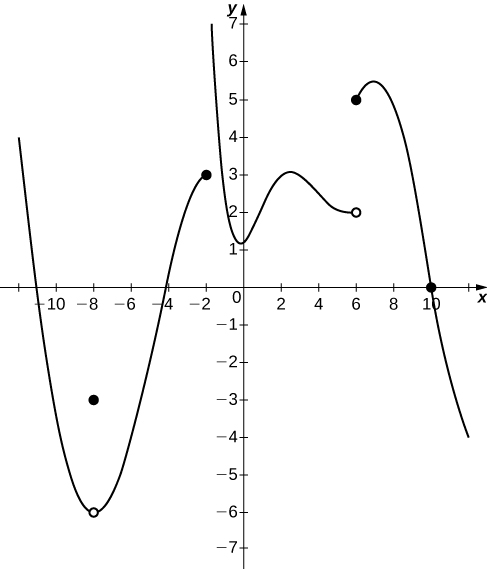
17. ![]()
18. ![]()
Solution
False; ![]()
19. ![]()
20. ![]()
Solution
False; ![]() DNE since
DNE since ![]() and
and ![]() .
.
In the following exercises, use the following graph of the function ![]() to find the values, if possible. Estimate when necessary.
to find the values, if possible. Estimate when necessary.
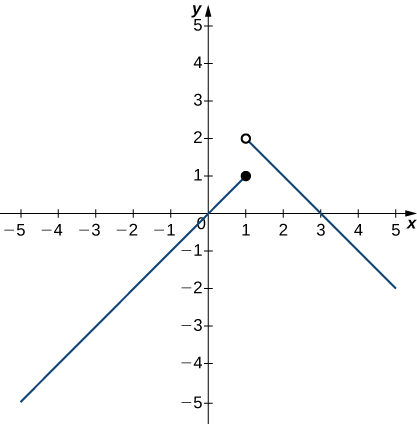
21. ![]()
22. ![]()
Solution
2
23. ![]()
24. ![]()
Solution
1
25. ![]()
In the following exercises, use the graph of the function ![]() shown here to find the values, if possible. Estimate when necessary.
shown here to find the values, if possible. Estimate when necessary.
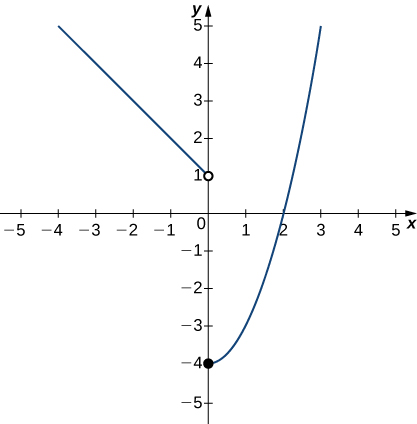
26. ![]()
Solution
1
27. ![]()
28. ![]()
Solution
DNE
29. ![]()
In the following exercises, use the graph of the function ![]() shown here to find the values, if possible. Estimate when necessary.
shown here to find the values, if possible. Estimate when necessary.

30. ![]()
Solution
0
31. ![]()
32. ![]()
Solution
DNE
33. ![]()
34. ![]()
Solution
2
35. ![]()
In the following exercises, use the graph of the function ![]() shown here to find the values, if possible. Estimate when necessary.
shown here to find the values, if possible. Estimate when necessary.
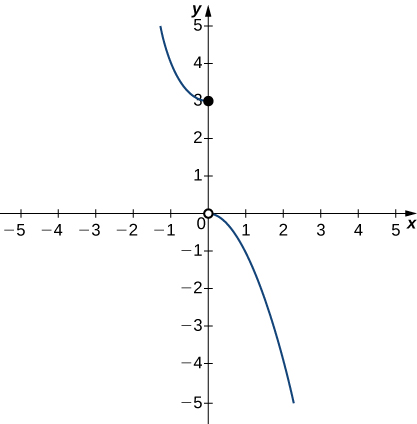 =0 and is the left half of an upward opening parabola with vertex at the closed circle (0,3). The second exists for x>0 and is the right half of a downward opening parabola with vertex at the open circle (0,0).”>
=0 and is the left half of an upward opening parabola with vertex at the closed circle (0,3). The second exists for x>0 and is the right half of a downward opening parabola with vertex at the open circle (0,0).”>
36. ![]()
Solution
3
37. ![]()
38. ![]()
Solution
DNE
In the following exercises, use the graph of the function ![]() shown here to find the values, if possible. Estimate when necessary.
shown here to find the values, if possible. Estimate when necessary.
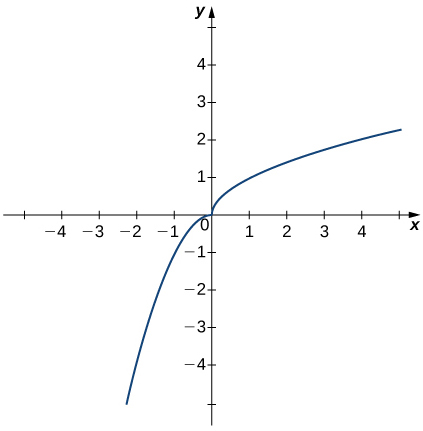
39. ![]()
40. ![]()
Solution
0
41. ![]()
In the following exercises, use the graph of the function ![]() shown here to find the values, if possible. Estimate when necessary.
shown here to find the values, if possible. Estimate when necessary.
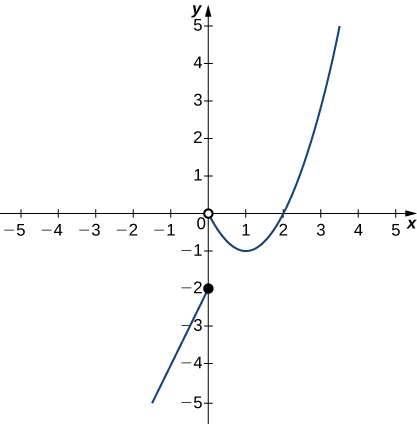 0, and there is a closed circle at the origin.”>
0, and there is a closed circle at the origin.”>
42. ![]()
Solution
−2
43. ![]()
44. ![]()
Solution
DNE
45. ![]()
46. ![]()
Solution
0
In the following exercises, sketch the graph of a function with the given properties.
47. ![]() , the function is not defined at
, the function is not defined at ![]() .
.
48. ![]() ,
, ![]()
Solution
Answers may vary.
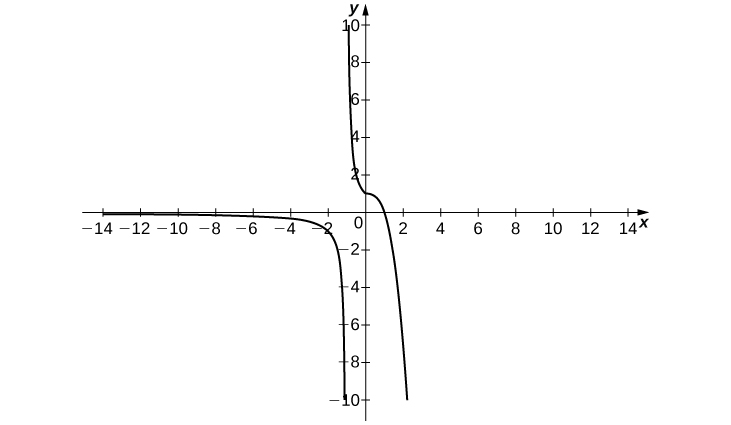
49. ![]() ,
, ![]()
50. ![]() ,
, ![]()
Solution
Answers may vary.
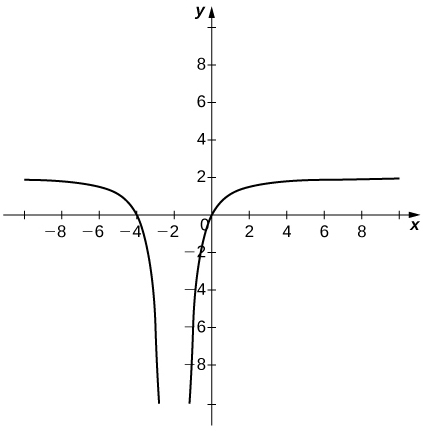
51. 
52. Shock waves arise in many physical applications, ranging from supernovas to detonation waves. A graph of the density of a shock wave with respect to distance, ![]() , is shown here. We are mainly interested in the location of the front of the shock, labeled
, is shown here. We are mainly interested in the location of the front of the shock, labeled ![]() in the diagram.
in the diagram.
 p2, and xsf on the x axis. It consists of y= p1 from 0 to xsf, x = xsf from y= p1 to y=p2, and y=p2 for values greater than or equal to xsf.”>
p2, and xsf on the x axis. It consists of y= p1 from 0 to xsf, x = xsf from y= p1 to y=p2, and y=p2 for values greater than or equal to xsf.”>
- Evaluate
 .
. - Evaluate
 .
. - Evaluate
 . Explain the physical meanings behind your answers.
. Explain the physical meanings behind your answers.
Show Answer
a. ![]()
b. ![]()
c. DNE unless ![]() . As you approach
. As you approach ![]() from the right, you are in the high-density area of the shock. When you approach from the left, you have not experienced the “shock” yet and are at a lower density.
from the right, you are in the high-density area of the shock. When you approach from the left, you have not experienced the “shock” yet and are at a lower density.
53. A track coach uses a camera with a fast shutter to estimate the position of a runner with respect to time. A table of the values of position of the athlete versus time is given here, where ![]() is the position in meters of the runner and
is the position in meters of the runner and ![]() is time in seconds. What is
is time in seconds. What is ![]() ? What does it mean physically?
? What does it mean physically?
| |
|
|---|---|
| 1.75 | 4.5 |
| 1.95 | 6.1 |
| 1.99 | 6.42 |
| 2.01 | 6.58 |
| 2.05 | 6.9 |
| 2.25 | 8.5 |
Glossary
- infinite limit
- A function has an infinite limit at a point
 if it either increases or decreases without bound as it approaches
if it either increases or decreases without bound as it approaches 
- intuitive definition of the limit
- If all values of the function
 approach the real number
approach the real number  as the values of
as the values of  approach
approach  ,
,  approaches
approaches 
- one-sided limit
- A one-sided limit of a function is a limit taken from either the left or the right
- vertical asymptote
- A function has a vertical asymptote at
 if the limit as
if the limit as  approaches
approaches  from the right or left is infinite
from the right or left is infinite

![The graph of a function f(x) described by the above limits and values. There is a smooth curve for values below x=-2; at (-2, 3), there is an open circle. There is a smooth curve between (-2, 1] with a closed circle at (1,6). There is an open circle at (1,3), and a smooth curve stretching from there down asymptotically to negative infinity along x=3. The function also curves asymptotically along x=3 on the other side, also stretching to negative infinity. The function then changes concavity in the first quadrant around y=4.5 and continues up.](https://s3-us-west-2.amazonaws.com/courses-images/wp-content/uploads/sites/2332/2018/01/11202918/CNX_Calc_Figure_02_02_015.jpg)

Hint
Use 0.9, 0.99, 0.999, 0.9999, 0.99999 and 1.1, 1.01, 1.001, 1.0001, 1.00001 as your table values.